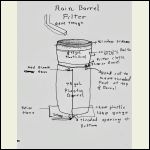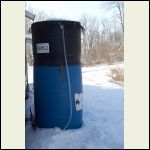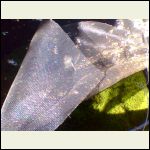|
| Author |
Message |
MO Cabin
Member
|
# Posted: 26 Apr 2016 06:36am
Reply
I have been bring water to my cabin for 10 years in the form of 55 gallon drums. I am looking to upgrade to something more sustainable and fairly simple, originally I planned an elaborate and complex system but after doing more research I found it to be too expensive. The majority of the water will be used for utility purposes, showering and bathing children , a small amount may be used to cook with if we needed it. I plan on buying a stock norwesco 325 gal tank (like the one pictured) from the local farm supply store and using exterior paint to paint the tank dark green or brown. I have already purchased a shuflo pump and plan on making a portable dolly system but as of now I plan on putting the tank 3-4 feet in the air so that I can fill buckets and to get a little bit of gravity feed. As I build on the system I want to add the four 55 gal drums that I already have into the storage system. I have looked at so many different ideas that I am not sure what to do. If you have personally tried something or have pictures how yours works please give me suggestions, I have reached critical mass from researching so many different methods and would like to hear from people with experience on the subject.
My questions are
1) best way to install overflow diverter on the tank without drilling a hole in the tank.
2) I already built a solid table out of scrap treated 6x6 and 2x8s (built similar to deck construction except the joists are 3 feet apart instead of 16inches). Will this support a 325 gallon tank? Or what is another easy way to get a tank up off the ground?
3) how do you suggest to do the diverter from the gutters to the tank. I am looking at this diverter because it looks very simple and is cheap, http://www.amazon.com/Flex-Drain-37043-Raindrop-Rainwater-Colander/dp/B008BMJSL6/ref= pd_sim_60_2?ie=UTF8&dpID=41haymWpGEL&dpSrc=sims&preST=_AC_UL160_SR128%2C160_&refRID=1 FZKZ667N5KJ8SXGQPXQ,
4) what do you recommend using for a first flush and filter system before the water enters the storage tank.
5) what method to get the rainwater into the tank without drilling into the tank.
6) best way to add extra tanks on the system without drilling.
7) Am I missing or overlooking something?
Thanks for taking time to help me out.
|
|
Just
Member
|
# Posted: 26 Apr 2016 08:54am
Reply
this is what we have ,worked well last 9 years ,We add chlorine once a week . plus boil drinking portion only ,
CCE02142011_00000_2.jpg
| 
100_1592_2.jpg
| 
moss growes on top helps eat bacteria
|  |
|
|
bldginsp
Member
|
# Posted: 26 Apr 2016 08:58am - Edited by: bldginsp
Reply
I've been keeping a 2500 gallon tank full from rainwater for the last 5 seasons during a drought.
Excellent instructions from Texas:
http://www.twdb.texas.gov/publications/brochures/conservation/doc/RainwaterHarvesting Manual_3rdedition.pdf
The best way to filter the water is on the gutter itself-keep as much junk out of the water as possible at the source- rather than trying to filter it after its in the pipes. So I bought this expensive gutter filter and it was worth it:
http://www.gutterglove.com/
My first flush diverter is in line right after the gutter, see the photo. Major issue is draining the first flush diverter. It must drain itself after each rainfall to be ready for the next, if you aren't there to do it.. So you put a little weep hole in it- but how do you keep that from clogging with gunk? I put a water irrigation filter inside the diverter, which was wrapped with landscape cloth as a primary filter. Works most of the time.
I don't see a problem with drilling a hole in a tank for overflow. That's what I did- the fitting isn't too expensive and you just have to get a large hole saw. Two holes is the best way to go.
Filter drinking water with a Berkey filter.
Hope this helps
|
|
Steve961
Member
|
# Posted: 26 Apr 2016 02:35pm - Edited by: Steve961
Reply
MO Cabin:
Here's what I did. I found an as new 275 gallon food grade tote bin for $145 and wrapped it in black plastic - way easier than painting it. I built my own diverter using PVC pipe with a field hockey ball for the internal float. You can see how the overflow is integrated into the entry pipe - it works just fine. I also used an adjustable valve for the drain, instead of just a drilled hole, so I could adjust the water drain flow and easily clean it out when needed.
I use a Leaf Eater rain head to keep the debris out of the tank. Only $32 at Amazon. I'm pleased with its performance so far.
Leaf Eater Rain Head
.
|
|
Ontario lakeside
Member
|
# Posted: 26 Apr 2016 09:24pm
Reply
We also wrapped our tank with a black tarp. We do minimal (screen) filtering before the water enters the tank. I have out outside hose on a float that keeps takes the water from 1 foot below the surface. any material that gets in sinks to the bottom or floats on top and is not a problem. I put a 1/4 or 1/2 a chlorine puck in as needed. I would advise keeping the tank on the ground, you can always siphon water into a bucket. I start a siphon with a hose and just hook the free end higher than the top of the tank. lower the free end and fill buckets any time.
For the line going into the 12 volt pump, I pre-filter with a shuflo strainer in line.
simple and works well for us.
|
|
DaveBell
Moderator
|
# Posted: 27 Apr 2016 12:47pm
Reply
Rainwater Filter System
Clorox is more dependable than the UV light.
Treatment amounts can be found on the Net.
|
|
MO Cabin
Member
|
# Posted: 27 Apr 2016 05:51pm
Reply
Steve961 how did you attach the entry pipe to the Inc tote.
|
|
Steve961
Member
|
# Posted: 27 Apr 2016 06:41pm
Reply
MO Cabin:
I first cut a hole in the top cap sized for the male portion of a 2" PVC threaded male adapter. I then trimmed the male portion to so that when it was screwed into a female adapter it would fit tightly with an appropriately sized o-ring between them. Kind of a kludge, but it seems to work well.
|
|
|
creeky
Member
|
# Posted: 27 Apr 2016 07:23pm
Reply
Just's water system for rainwater collection is the one I copied.
I have a plastic filter in the rain trough to keep leaves/stuff out.
The Aussie's have a real good rainwater collection report out. They found "first flush" devices to be of minimal use.
A UN report found 50 lbs of sand as a filter is sufficient for water purification. and, as Just points out, the green goo that develops actually eats bacteria.
You can find the sand at walmart. playground sand. I rinsed mine in a friends tub before using.
|
|
bldginsp
Member
|
# Posted: 27 Apr 2016 07:54pm
Reply
Quoting: DaveBell Clorox is more dependable than the UV light.
Bleach doesn't kill cysts, UV does, but only if used correctly. There seems to be debate about whether cysts make it through ceramic filters.
|
|
DaveBell
Moderator
|
# Posted: 27 Apr 2016 09:17pm
Reply
Quoting: bldginsp Bleach doesn't kill cysts, UV does, but only if used correctly. There seems to be debate about whether cysts make it through ceramic filters.
Cysts are 7-10 microns. Last filter is 0.9 micron.
The bleach is not for the cysts.
|
|
MO Cabin
Member
|
# Posted: 28 Apr 2016 10:34am
Reply
The more I think about it the more I like the sand/rock filter, but a 45 gal drum is not big enough for my family of five, I need to figure out how to make a filter that will work on a bigger 300-500 gallon tank.
|
|
Steve961
Member
|
# Posted: 28 Apr 2016 12:43pm
Reply
If you have the vertical height, you could use two tote bins stacked together. The top one could be your sand filter, and the bottom could be for water storage.
|
|
RiverCabin
Member
|
# Posted: 28 Apr 2016 01:31pm - Edited by: RiverCabin
Reply
MO Cabin,
Given your name, I'm assuming your cabin is in Missouri as is mine
http://imgur.com/a/mB3I4
Above is an album I threw together a while back, it shows how I collect my water (a pretty poor system but effective nonetheless).
To answer your questions:
1. I just drilled a one inch hole at the top and put in a hose barb. The hose when installed leads to a little creek.
2. I originally built a deck like you did and it did not work. As the deck settled, it became askew and eventually tipped and shattered under the weight. Mine now has has 4x4 corner posts sunk 18 inches with 80lbs of quikrete per post. its cross braced with 2x6's. It has worked fine but has begun to twist. If I were to do it again I'd use 6x6 corners. Remember 300 gallons of water is over 2400 lbs.
3. I run straight from the gutters to the tank.
4. I don't. Specifically, the location of my tank and the roof from where it draws water gets little debris. I flush and drain the tank when I close up the tank in the fall. If I needed to flush the tank during the prime season, I'd aim to do it when we were expecting rain. My system collects 120 gallons per 1 inch of rainfall so it fills rather quickly except for the hottest months of summer. I also use pool tablets in the tank to avoid algae.
5. I used the top fill provision on the cage tank I bought and made a bib around the line from the gutter with plastic to keep out any large debris.
6. Dunno? If it were me and I had multiple tanks on the platform, Id connect them together at the bottom and let water pressure do your work to fill the other tanks.
Instead of answering #7, I'll say a few things. As you can see from my system, it only exists to flush my toilet. My family of four regularly stays at the cabin weekly during the summer months for spans of time up to one week. We have never found it necessary to collect rainwater for drinking. We just tote in a couple cases of Sams choice water (about a $6 expenditure) and use that water for drinking and cooking. As to showering, as my cabin is on a river, my boys rarely (never) shower at the cabin. As to my wife and I, if compelled we use a solar shower with water from the water collection system.
|
|
MO Cabin
Member
|
# Posted: 29 Apr 2016 10:00am
Reply
Rivercabin, that is a great spot. What river are you on?
|
|
Julie2Oregon
Member
|
# Posted: 29 Apr 2016 07:10pm
Reply
Quoting: Steve961 If you have the vertical height, you could use two tote bins stacked together. The top one could be your sand filter, and the bottom could be for water storage.
That's a neat idea, Steve! I'm thinking you could probably size the sand filter bin according to the typical rainfall you get per occurrence and the surface area that your gutters/spout collects for your tank.
In other words, the sand filter vessel in an area like mine that doesn't have high annual rainfall averages and collection on the surface area of a small cabin wouldn't necessarily need a sand filter bin that big. I don't know how long it takes the water to filter through the sand and go into the water tank, but for the rain in my area and the surface area, a day's worth of rain would probably be only 4-5inches above the sand once it was saturated.
If there was an unprecedented deluge or sustained rain for days that the filter bin couldn't handle, you could divert to a standby barrel with a simple strainer and purify that water later.
|
|
RiverCabin
Member
|
# Posted: 2 May 2016 01:35pm
Reply
Quoting: MO Cabin Rivercabin, that is a great spot. What river are you on?
Let's just say one of those cold clear rivers in south eastern Missouri. I love the internet but I'm a bit cautions about giving out too much information.
|
|
MO Cabin
Member
|
# Posted: 2 May 2016 11:13pm
Reply
That is a wise practice, if it is the river I am thinking of you are a lucky man.
|
|
|

